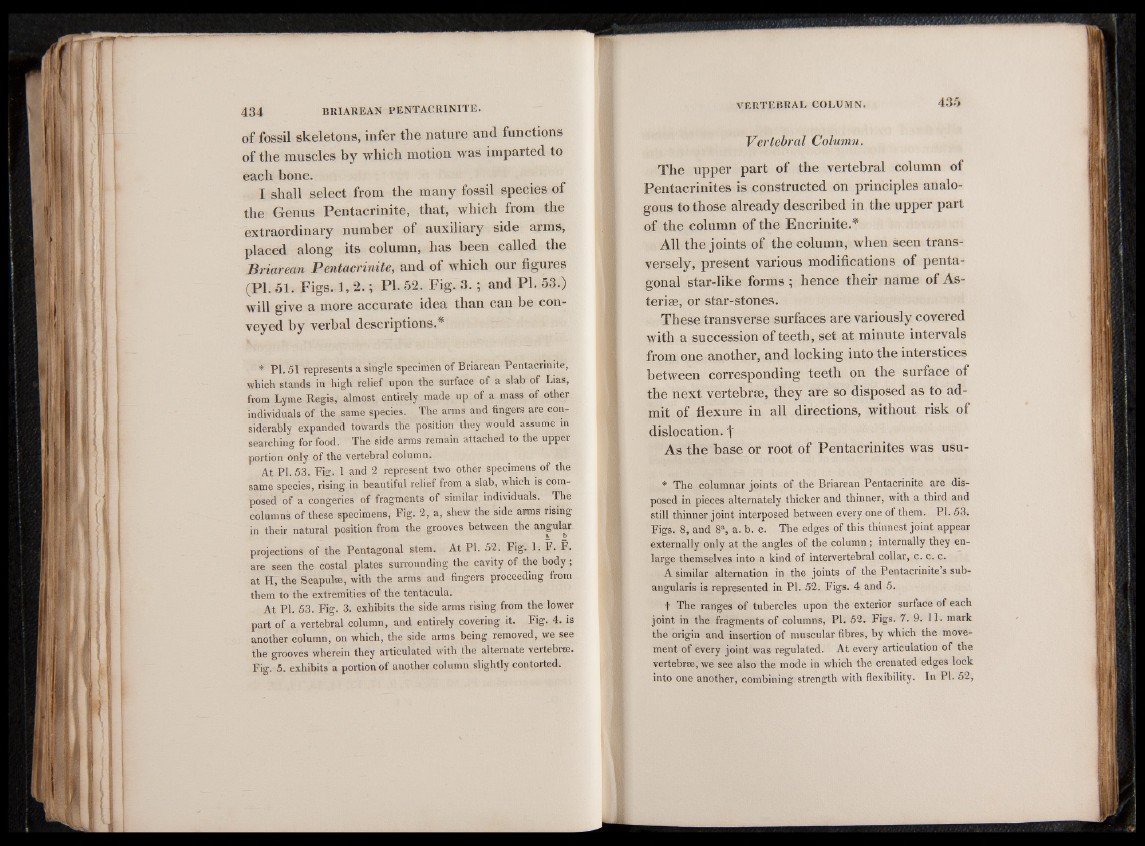
of fossil skeletons, infer the nature and functions
of the muscles by which motion was imparted to
each bone.
I shall select from the many fossil species of
the Genus Pentacrinite, that, which from the
extraordinary number of auxiliary side arms,
placed along its column, has been called the
Briarean Pentacrinite, and of which our figures
(PI. 51. Figs. 1, 2.; PI. 52. Fig. 3.; and PI. 53.)
will give a more accurate idea than can be conveyed
by verbal descriptions.*
* PI. 51 represents a single specimen of Briarean Pentacrinite,
which stands in high relief upon the surface of a slab of Lias,
from Lyme Regis, almost entirely made up of a mass of other
individuals of the same species. The arms and fingers are considerably
expanded towards the position they would assume in
searching for food. The side arms remain attached to the upper
portion only of the vertebral column.
At PI. 53. Pig- 1 and 2 represent two other specimens of the
same species, rising in beautiful relief from a slab, which is composed
of a congeries of fragments of similar individuals. The
columns of these specimens, Fig. 2, a, shew the side arms rising
in their natural position from the grooves between the angular
projections of the Pentagonal stem. At PI. 52. Fig. 1. F. F.
are seen the costal plates surrounding the cavity of the body ;
at H, the Scapulse, with the arms and fingers proceeding from
them to the extremities of the tentacula.
At PI. 53. Fig. 3. exhibits the side arms rising from the lower
part of a vertebral column, and entirely covering it. Fig. 4. is
another column, on which, the side arms being removed, we see
the grooves wherein they articulated with the alternate vertebrte.
Fig. 5. exhibits a portion of another column slightly contorted.
Vertebral Column.
The upper part of the vertebral column of
Pentacrinites is constructed on principles analogous
to those already described in the upper part
of the column of the Encrinite.*
All the joints of the column, when seen transversely,
present various modifications of pentagonal
star-like forms ; hence their name of As-
teriae, or star-stones.
These transverse surfaces are variously covered
with a succession of teeth, set at minute intervals
from one another, and locking into the interstices
between corresponding teeth on the surface of
the next vertebrae, they are so disposed as to admit
of flexure in all directions, without risk of
dislocation, f
As the base or root of Pentacrinites was usu-
* The columnar joints of the Briarean Pentacrinite are disposed
in pieces alternately thicker and thinner, with a third and
still thinner joint interposed between every one of them. PL 53.
Figs. 8, and 8% a. b. c. The edges of this thinnest joint appear
externally only at the angles of the column; internally they enlarge
themselves into a kind of intervertebral collar, c. c. c.
A similar alternation in the joints of the Pentacrinite’s sub-
angularis is represented in PI. 52. Figs. 4 and 5.
f The ranges of tubercles upon the exterior surface of each
joint in the fragments of columns, PL 52. Figs. 7. 9. 11. mark
the origin and insertion of muscular fibres, by which the movement
of every joint was regulated. At every articulation of the
vertebrse, we see also the mode in which the crenated edges lock
into one another, combining strength with flexibility. In PI. 52,